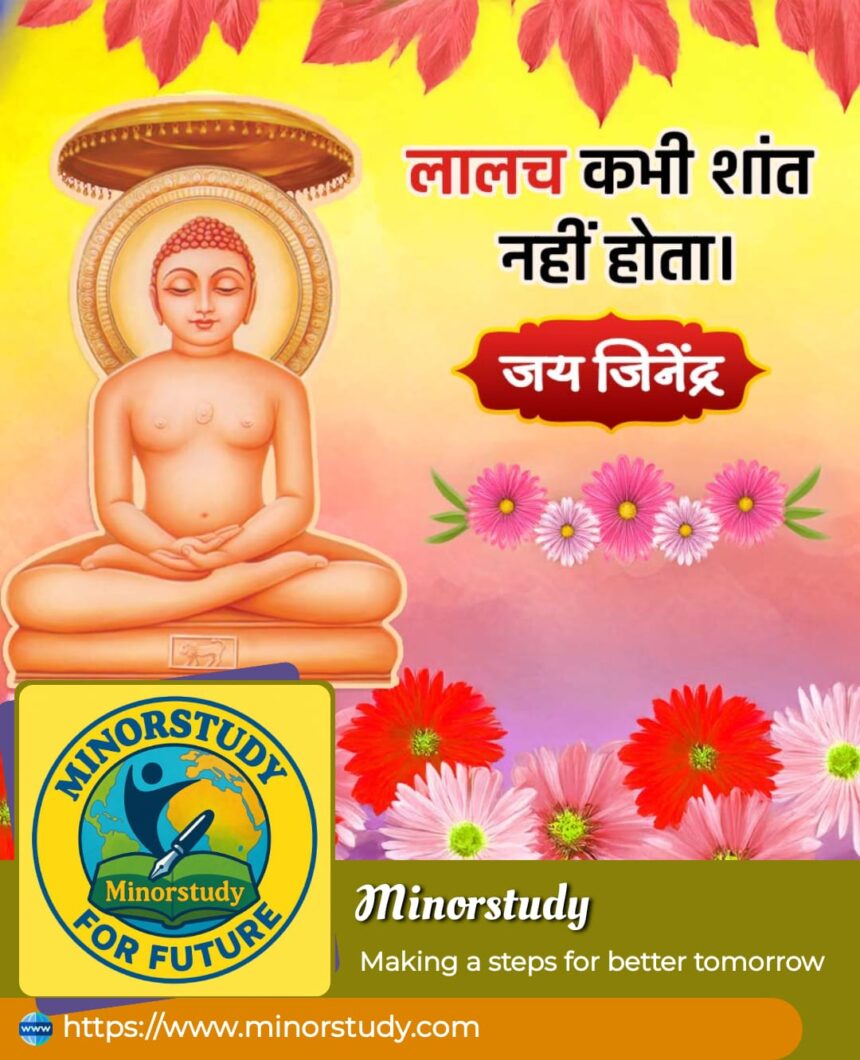5 Harsh Truths About Greed – Why ‘Lalach Kabhi Shaant Nahi Hota’ Is Jainism’s Most Powerful Lesson
“लालच कभी शांत नहीं होता।”
– A timeless Jain teaching that echoes across all spiritual paths.
Greed – or Lalach – is one of the most common yet deeply destructive human tendencies. No matter how much we have, we want more — more money, more fame, more power, more possessions. This eternal dissatisfaction is not just a psychological issue; it’s a spiritual blockage that traps the soul in samsara – the cycle of birth and rebirth.
- 📜 History and Spiritual Origins of the Phrase
- 🧩 5 Harsh Truths About Greed (Lalach)
- 📆 Timeline: How Jainism Has Tackled Greed Over the Ages
- 🙋♀️ FAQs – People Also Ask
- ✨ Significance in Today’s World
- 🧘♂️ Observance: How to Practice This Teaching Daily
- 📚 Important Points and Social Relevance
- 🎉 Thoughtful Wishing
- 🧠 Daily Life Impact: Why This Teaching is Essential
- 🪷 Conclusion – The Fire That Cannot Be Fed
In Jainism, this principle is deeply emphasized. The phrase “Lalach Kabhi Shaant Nahi Hota” is not just a proverb — it’s a mirror to human desire, a warning, and a guide toward inner peace.
Let’s explore its history, significance, practical meaning, timeline, daily life impact, and much more in this in-depth, human-friendly article of 1200+ words.
📜 History and Spiritual Origins of the Phrase
“Lalach Kabhi Shaant Nahi Hota” originates from ancient Jain scriptures and traditions that strongly emphasize aparigraha (non-possessiveness) and vairagya (detachment).
🕉️ Root Concepts in Jainism:
Lobha (Greed): One of the four major kashayas (passions) along with anger (krodha), pride (mana), and deceit (maya).
Jain Acharyas such as Acharya Kundakunda and Acharya Hemachandra described Lobha as a direct hindrance to moksha (liberation).
The core Jain ethical principle, Aparigraha, exists solely to combat Lalach.
🪶 Jain Agamas & Teachings:
“The more you desire, the more you suffer.”
“Greed multiplies desires, but contentment multiplies peace.”
🧩 5 Harsh Truths About Greed (Lalach)
Greed Has No End – It Grows Like Fire
Just like fire never says “enough” to fuel, the mind never says “enough” to desires.
Lalach Leads to Suffering, Not Satisfaction
The more you accumulate, the more you fear losing.
Greed Destroys Relationships
It replaces love with competition and harmony with conflict.
Greed Is the Root of Environmental and Social Crisis
Overconsumption, exploitation of nature, and inequality all stem from human greed.
Lalach Blocks Spiritual Progress
According to Jainism, liberation is impossible unless greed is fully eliminated.
📆 Timeline: How Jainism Has Tackled Greed Over the Ages
| Time Period | Contribution |
|---|---|
| ~599 BCE | Lord Mahavira taught Aparigraha as a central virtue |
| 2nd–5th century CE | Jain Acharyas wrote detailed scriptures warning against greed |
| 10th century CE | Jain temples and monks strictly practiced minimalism and detachment |
| 20th century | Jain leaders like Acharya Tulsi promoted Anuvrat Movement against materialism |
| 21st century | Jainism’s core ideas inspire minimalist and vegan movements worldwide |
🙋♀️ FAQs – People Also Ask
Q1. What is the meaning of “Lalach Kabhi Shaant Nahi Hota”?
It means that greed never ends. No matter how much one gains, they will still crave more unless they embrace detachment.
Q2. Why is greed considered dangerous in Jainism?
Greed keeps the soul bound in karmic bondage and hinders spiritual liberation (moksha).
Q3. How can one overcome greed?
Through self-discipline, meditation, aparigraha, charity, and inner reflection.
Q4. Is being ambitious the same as being greedy?
No. Ambition with ethics and limits is growth. Greed is unending desire at any cost.
Q5. What are Jain practices to reduce greed?
Vows of Aparigraha
Fasting
Daily introspection
Limiting possessions
✨ Significance in Today’s World
💸 Consumerism vs Contentment
We live in a hyper-materialistic era — buying more, hoarding more, wanting more.
This phrase reminds us: greed leads to stress, contentment to joy.
🧘 Minimalism Movement
The popularity of decluttering, simple living, and zero-waste lifestyles shows society is waking up to this truth.
Jainism has practiced it for thousands of years.
🔥 Mental Health and Emotional Well-being
Greed causes anxiety, comparison, and low self-worth.
Letting go creates mental peace, joy, and freedom.
🧘♂️ Observance: How to Practice This Teaching Daily
🪔 5 Simple Practices:
Start your day with gratitude – not with a wish list.
Give away what you don’t need – donate monthly.
Limit wants, not needs – live with intention.
Keep a “Lalach Diary” – write down where greed appeared and how you responded.
Fast or abstain weekly – reduce dependency and cravings.
🌼 Affirmation:
“I have enough. I am enough. I need no more to feel whole.”
📚 Important Points and Social Relevance
Lalach isn’t just about money – it can be for praise, control, fame, food, or validation.
Jain monks own almost nothing, yet radiate joy and peace — proof that peace comes from within, not possessions.
This message is not limited to Jains — it applies universally across all faiths and cultures.
💥 Greed in Society Leads To:
Corruption
Pollution
Inequality
Family Conflicts
War and Competition
And yet, the solution is simple: Conquer greed, and peace follows.
🎉 Thoughtful Wishing
🌸 “जय जिनेन्द्र।
हे जिनेंद्र भगवान, हमें लालच से मुक्ति दो।
हमें संतोष, दया और अपारिग्रह का मार्ग दिखाओ।
हमारी आत्मा को शांति और सच्चा सुख प्रदान करो।” 🌸
🧠 Daily Life Impact: Why This Teaching is Essential
| Life Area | With Lalach | Without Lalach |
|---|---|---|
| Mental Peace | Restlessness | Inner calm |
| Relationships | Jealousy, control | Love, harmony |
| Spirituality | Ego, desire | Detachment, liberation |
| Finance | Debt, overspending | Saving, mindful living |
| Environment | Waste, overuse | Sustainability |
🪷 Conclusion – The Fire That Cannot Be Fed
In the end, greed is not about what you own — it’s about what owns you. The Jain principle of “Lalach Kabhi Shaant Nahi Hota” is a spiritual compass in a noisy, hungry world.
If you truly wish to be happy — learn to want less.
“Lalach is a bottomless pit.
Fill your heart with contentment, and you’ll never feel poor again.”








